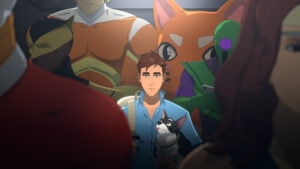The Two Point Games are known for their quirkiness and unique brand of humor. Two Point Hospital was an homage to one of my favorite classics: Theme Hospital. Two Point Campus took a different approach to handling a school curriculum but remained structurally similar to Hospital. Two Point Museum, on the other hand, fundamentally changed every aspect of its gameplay for the sake of its new Exhibits and Exploration systems. And it turned out way better than I expected.
Two Point Museum is the third game in the Two Point series of management simulators. Players take on the role of an up-and-coming curator as they develop the various museums scattered around Two Point County. Their aim as always is to be the best of the very best. A task made significantly more challenging by the increased level of creative freedom afforded to all hopefuls. Nevertheless, players who love the micromanagement aspect of the Two Point games will have reason to stay for a very long time.
The new Exhibits are the beating heart of every museum. They are displays that pique the curiosity of onlookers and trigger a want and need of them to know more. With the right decorations and carefully planned layouts, you can ensure that guests leave satisfied having experienced their dream visit. Who knows? they might even show their appreciation through patronage and a little visit to the cafeteria and gift shop. (Unless all roads lead there, regardless.)
Unlike previous games, Two Point Museum only has 5 major locations and a handful of pop-up locations. This is in contrast to previous games where nearly 2 dozen locations are available to unlock via post-launch support. But this is not necessarily a bad thing for Museum. What it lacks in quantity, it makes up for it with quality.
There are 5 general themes in the base game: Prehistory, Aquarium, Supernatural, Science, and Space. These can be considered starting points to unlock every exhibit type in the game. Given enough time, curators may choose to expand and purchase all available plots to showcase all 5 exhibit types – if your initial investments don’t bankrupt you from the get-go.
The newly revamped Star Rating also plays a significant role here. Gone are days of trying to reach that coveted 3-star rating and never coming back. Stars are rewarded gradually now, requiring players to get a certain number of stars in 2 or more museums plus earning at least a bronze trophy in a pop-up museum challenge. I really do like this new system they’ve cooked up. Not only do I have to plan for future expansions, but I now have reason to keep everything nice and tidy for my eventual return. I am so sorry to all my hospitals I left in worse condition than when I came in.
Expeditions are the main way you acquire new exhibits for your museum. The way it works is you assemble a team of your museum’s staff. You send them out for a set amount of time, and depending on the hazard and season, your team will have a short or extremely long trip. Having staff with the right set of skills may remove a hazardous event. But sometimes things can still go horribly wrong. In some cases, your staff will go “MIA” aka never to return. That is a sacrifice all in the pursuit of knowledge. At least that’s what I tell myself at night.
Successful expeditions will yield a new exhibit for the museum to display. There are hundreds of unique pieces to collect. Most are ready for display fresh out of the box, while others require multiple pieces to become a full Pristine set. And this is the part where I say I’m iffy on the rarities gimmick. Getting a Pristine set is supposed to bring me great joy. I know that feeling very well after playing Destiny 2 for many years. So, instead of feeling grateful that I got a new exhibit to display, I would often feel deflated if the rarity is Average or even Rare.
And while there are uses for such duplicates – for selling and study purposes in the Analysis Room, I can’t help but feel like I wasted expedition time on something of little value. I don’t know. Maybe it’s the Destiny 2 player in me wanting to get god rolls so badly (if you know, you know.) but I just can’t muster any enthusiasm for temporary placeholders.
Rarities aside, the exhibits themselves are true stars of the show. Two Point Museum retains the same charm and wit the series is always known for. What other games would have haunted toilets for displays that reduce the toilet comfort of guests who look at them? How devious. There are also clownfish that look exactly as you imagine them. Just don’t put them in the same tank as the bull sharks! Not all exhibits are there for purely comedic purposes. (Though the man-eating plants are pure comedy.) In the later part of the game, you will unlock high-tech exhibits that allow you to create automated security guards. This shows that they are capable of being practical and entertaining at the same time.
So far, my biggest gripe with the game is the deliberate slow start to every new location. I learned the hard way that you shouldn’t go all out with thoughts of grandeur immediately, even if you are deep into the main campaign. I had made the mistake of spending money on things, that in hindsight, appeared sound but cost me dearly. As a result, I was forced to go lean for long stretches and even forced to cut staff in a desperate attempt to lower costs. Mind you, I had already taken up sizable loans that were eating away at my monthly income. I eventually got out of the hole but the going back and forth between barely breaking even and being in debt severely derailed any plans I initially had for the place.
Things don’t become truly exciting until your first handful of successful Expeditions and you are afforded more room for creativity. This process I liken to a roller coaster ride. The slow build-up can become boring if it takes too long. But once you go over the top, it’s a non-stop thrill ride to the very end.
Another problem I have is with some janky interactions. For some reason, I can’t complete a room unless it has access to the outside. That would be great if I was warned before I put down furniture. But no. I would have to cancel the whole complete room and then I have the option to make a doorway. It’s a minor annoyance in the grand scheme of things but it’s happened on more than one occasion after buying a new plot.
Of course, even the most Pristine exhibits will not attract eyeballs if their surroundings are bland and lifeless. This is where the improved Decorations system comes into play. This is probably where the majority of my playtime has gone into. Long stretches of playtime have I dedicated to applying floor decals, banners, and wall decorations. Literal hours were spent designing and re-designing areas based on every new addition to my museum. All in an attempt to present my exhibits in the best light possible. Speaking of which, the addition of hanging decorations is also a welcome sight as it’s something I’ve wished for way back when and I’m so happy to have them be part of the base game.
On top of that, we have triangle tiles and diagonal walls in the game. I can’t believe how much of an impact it has had on layout possibilities. And let’s not overlook the handy color picker for all items in the game! I used to be content with color variants, but now I expect custom colors to be added in every game moving forward.
Zone Management is a new feature that’s been in the works since the first game. It allows the player to designate an entire area into a color-coded zone. You can then command your staff to only roam within the area, never straying beyond it. I like the idea overall but I have two main concerns with its implementation. Firstly, I can’t change zones once they are set. I have no choice but to make a zone and that becomes the defacto zone in that area. Secondly, I can only assign one zone to each staff member. The issue is that if you have only one Analysis Room and your experts are assigned to another building, they won’t move to the other building on their own. A quick fix is unticking the box that restricts that researcher to one place. I know the feature is going to be iterated upon and changes will be made later on but for now, it is an inconvenience.
Another new thing they’ve added is the Pop-up museums. These are timed challenges that test your management skills under certain pre-set conditions. One museum sees you becoming the head of security and it’ll be your job to stop gangs of thieves from stealing the displays. Another one will stretch your ability to promote and generate excitement for the exhibit. I very much like these levels. Not only do they provide a break from regular gameplay, but I went back to my museums with new layouts in mind.
The biggest change in how I went about doing things was the way I treated guests. In the past, I was always looking for the most efficient way to get as many NPCs through as quickly as possible – be it patients or students of a 4-year course. So, having to find ways to extend visits and having them inside museum grounds for as long as possible was shocking to me. I have to fulfill their dream visit needs while tending to their base needs of food and entertainment. I had a blast trying to solve this particular puzzle. But it was satisfying to see all my efforts bear fruit as guests have their dream visit. (I’m also grateful for their generous patronage.)
Two Point Museum is the culmination of lessons learned from both previous Two Point games, reinforced with copious amounts of feedback from the community. It boasts the most creative freedom in the series so far. It’s also the most sophisticated in terms of underlying support systems. I believe this one can go the distance and we’ll see more and more content being released in the months and years after launch. So, if you are into the micromanagement aspect of Two Point games, you will absolutely love Two Point Museum. For everyone else with a passing interest in management sim games, give it a shot, at least.
This review is based on a PC review copy provided to us by the developers/publishers.
Two Point Museum
Two Point Museum is the culmination of lessons learned from both previous Two Point games, reinforced with copious amounts of feedback from the community.
The Good
- Expands upon the ideas first established in previous Two Point games
- The deepest in terms of customization
- Quality over quantity
- Always something to do, to unlock, to upgrade
- Pop-up challenges are an interesting twist
The Bad
- There are still some janky interactions
- Exhibit rarities sometimes dampen enthusiasm











